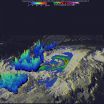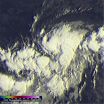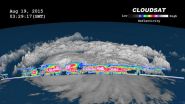NASA's GPM Satellite analyzes Tropical Storm Danny's rain structure
2015-08-20
(Press-News.org) Tropical Storm Danny became the fourth named storm of the season on August 18 when it formed in the central Atlantic about 1,660 miles east of the Windward Islands. The Global Precipitation Measurement (GPM) mission core satellite passed over Danny the next day and analyzed the structure of its rainfall.
Danny originated from an African easterly wave that moved off of the coast of Africa 4 days earlier on the 14th of August. Storms that form in this region are known as Cape Verde storms and typically form towards the height of hurricane season.
In a typical season, there are about 10 named storms and 6 hurricanes. With this year being a potentially strong El Nino year, Atlantic hurricanes are usually suppressed. However, it only takes one. Hurricane Andrew, which devastated south Florida back in 1992, formed during an El Nino. Also, not all El Nino's are alike.
The GPM core satellite is a joint effort. It is managed by both NASA and the Japan Aerospace Exploration Agency.
GPM captured an image of Danny at 07:26 UTC (3:26 am EST) on August 19 and showed rain rates from the GMI overlaid on GOES-East satellite infrared data that showed the extend of Danny's clouds.
At NASA's Goddard Space Flight Center in Greenbelt, Maryland, a 3-D rendering of Danny was made using data from the GPM DPR (Dual-frequency Precipitation Radar). GPM showed that Danny was still in the process of becoming organized. The rain structure was still very asymmetric as noted by a large rain band being located mainly on the eastern side of the storm. Within this rain band, GPM detected rain rates of up to 73.9 mm/hour. At the time of this image, Danny was still a minimal tropical storm with sustained winds estimated at 50 mph by the National Hurricane Center (NHC).
At 5 a.m. EDT (0900 UTC) on August 20, the center of Tropical Storm Danny was located near latitude 12.2 North, longitude 43.7 West. That's about 1,200 miles (1,930 km) east of the Lesser Antilles. Danny was moving toward the west near 10 mph (17 kph). A turn to the west-northwest with no change in forward speed is expected during the next 48 hours.
Maximum sustained winds remain near 50 mph (85 km/h) with higher gusts. Some strengthening is still possible, and the NHC said that Danny could become a hurricane on Friday. The estimated minimum central pressure is 1000 millibars.
Danny is over warm water, and the wind shear is light. Danny is still forecast to become the first hurricane of the Atlantic season within the next day or so and remain a hurricane as it approaches the Windward Islands.
INFORMATION:
[Attachments] See images for this press release:


ELSE PRESS RELEASES FROM THIS DATE:
2015-08-20
TORONTO, ON, August 20, 2015 - Women diagnosed with ductal carcinoma in situ (DCIS) are twice as likely to die from breast cancer compared to the general U.S. population, according to a new study led by Dr. Steven Narod.
"Our work shows that DCIS has more in common with small invasive cancers than previously thought," explains Dr. Narod, a scientist with Women's College Research Institute and a professor with the Dalla Lana School of Public Health at the University of Toronto. "In these cases, we've found that there's an inherent potential for DCIS to spread to other ...
2015-08-20
Afatinib (trade name: Giotrif) has been approved since September 2013 for the treatment of adult patients with locally advanced or metastatic non-small cell lung cancer (NSCLC) with activating EGF receptor mutations who have not been treated with an EGF receptor tyrosine-kinase inhibitor (EGFR TKI). After a first early benefit assessment in February 2014, the German Institute for Quality and Efficiency in Health Care (IQWiG) now reexamined whether the drug offers an added benefit over the appropriate comparator therapy. The new benefit assessment was conducted because a ...
2015-08-20
Putnam Valley, NY. (Aug. 20, 2015) - Tendon injuries, especially those acquired while engaging in sports, are not easily healed due to the fibrous nature of tendon tissues which transmit forces from muscle to bone and protect surrounding tissues against tension and compression. Tendon injuries to wrists, knees, elbows and rotator cuffs, often from over use when playing golf or tennis, are increasingly common for both professional and amateur athletes ("weekend warriors") alike.
Previous studies in which human fetal progenitor tenocyte (hFPT) transplantation stimulated ...
2015-08-20
Researchers from Memorial Sloan Kettering Cancer Center (MSK) have announced results from the first published basket study, a new form of clinical trial design that explores responses to drugs based on the specific mutations in patients' tumors rather than where their cancer originated.
Published in the New England Journal of Medicine, the early phase II study, led by MSK Physician-in-Chief and Chief Medical Officer José Baselga, MD, PhD, looked at the effect of vemurafenib (Zelboraf®) in multiple nonmelanoma BRAFV600-mutated cancers in 122 patients from 23 ...
2015-08-20
HOUSTON - (Aug. 20, 2015) - Texans without health insurance are twice as likely to skip seeking primary and mental health care because of cost. That's one of the findings of a new survey released today by Rice University's Baker Institute for Public Policy and the Episcopal Health Foundation.
The report found that in the past year 32 percent of uninsured adult Texans said they had skipped primary care due to costs, compared with 16 percent of adults who have health insurance. When it comes to mental health care or counseling, 12 percent of uninsured Texans said they had ...
2015-08-20
NASA's CloudSat Satellite passed over Super Typhoon Atsani as it moved through the western North Pacific Ocean. CloudSat looked at the super typhoon from the side, revealing heavy rainfall in a sloping eyewall.
Typhoon Atsani strengthened into a super typhoon on August 19, 2015 at 0000 UTC. CloudSat flew over Atsani at 03:27 UTC, shortly after it became a super typhoon when maximum sustained winds were near 130 knots (150 mph). Atsani was equivalent to a category 4 strength hurricane.
CloudSat's cloud profiling radar (CPR), passed just to the west of Super Typhoon Atsani's ...
2015-08-20
In the 1930s, Irving Langmuir and his colleague Katharine Blodgett were working long days in the General Electric Company's research laboratory. Together, they discovered that by spreading molecules with volatile organic solvents on the surface of water, they could create a one-molecule-thick film and use it as an anti-reflective coating for glass. Later named Langmuir-Blodgett assembly, this thin-film fabrication technique became popular for creating molecule or nanoparticle monolayers and is commonly used until this day.
Since Langmuir-Blodgett assembly was first reported ...
2015-08-20
Reston, Va. (August 20, 2015) - A molecular imaging biomarker is able to detect fast-growing primary prostate cancer and distinguish it from benign prostate lesions, addressing an unmet clinical need. The new research, published in the July 2015 issue of The Journal of Nuclear Medicine, is significant for patients with suspected prostate cancer that has not been confirmed by standard biopsy.
"We were able to demonstrate in our research that PSMA PET imaging was more specific than MR imaging for detection of clinically significant high-grade prostate cancer lesions, and ...
2015-08-20
WASHINGTON, D.C., August 20 -- A first-of-its-kind, nationally representative study of siblings supports previously published research on unrelated individuals that links specific genotypes to educational attainment among adults in their mid-20s to early 30s. The research, published today in AERA Open, a peer-reviewed journal of the American Educational Research Association, found that, within families, an adolescent with a higher "polygenic score"--which summarizes previously identified genome-wide associations for educational attainment--than her or his sibling tended ...
2015-08-20
Summary: The ideal management strategy for primary cardiogenic shock is a matter of debate. After some early discouraging experiences, the use of extracorporeal life support for patients with cardiogenic shock is having a resurgence. A report from researchers in Padua, Italy finds that patients who have an acute onset of cardiogenic shock, for example following a heart attack, and are placed on extracorporeal life support, fare better than those who have a chronic cardiac pathology. In an accompanying editorial, Dr. Vivek Rao of the University of Toronto puts the findings ...
LAST 30 PRESS RELEASES:
[Press-News.org] NASA's GPM Satellite analyzes Tropical Storm Danny's rain structure


